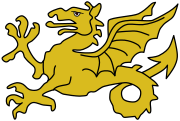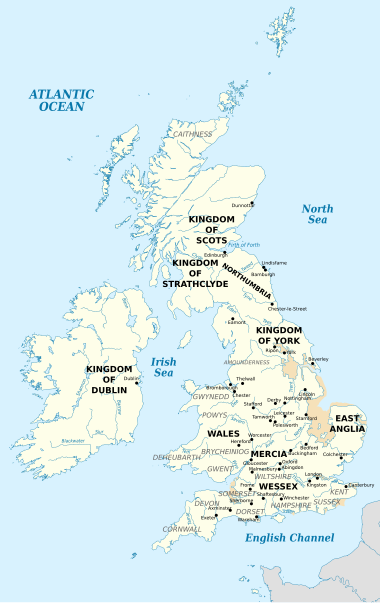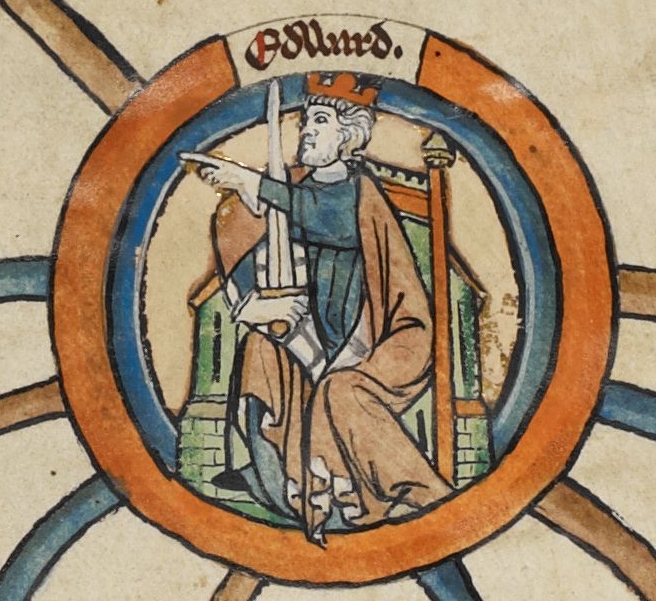- 899-924: King of the Anglo-Saxons
Edward the Elder, King of the Anglo-Saxons, was born circa 870 to Alfred the Great (849-899) and Ealhswith (c852-905) and died 17 July 924 of unspecified causes. He married Ecgwynn (c875-) 893 JL in Wessex. He married Ælfflæd (c880-) 899 JL in Wessex. He married Eadgifu of Kent (c902-968) 919 JL in Wessex.
Edward the Elder, King of the Anglo-Saxons succeeded his father, Alfred the Great (849-899), as King of the Anglo-Saxons: 899-924, and proceeded to carry on Alfred's work in fighting the Danes and extending the dominion of Wessex over England. He took possession of East Anglia and Mercia. His lordship was at various times recognized by the Northumbrians, the Welsh, the Scots and the Britons of Strathclyde.
Biography
House of Wessex
He was of the royal English dynasty called House of Wessex, a family originating in the southwest corner of England and gradually increased in power and prestiege. The House became rulers of all the country with the reign of Alfred the Great in 871 and lasting until Edmund Ironside in 1016. This period of the English monarchy is known as the Saxon period.
Reign of Edward
Edward the Elder (Old English: Eadweard cyning) was an English king. He became king in 899 upon the death of his father, Alfred the Great (849-899). His court was at Winchester, previously the capital of Wessex. He captured the eastern Midlands and East Anglia from the Danes in 917 and became ruler of Mercia in 918 upon the death of Æthelflæd, his sister.
All but two of his charters give his title as "Anglorum Saxonum rex" or "king of the Anglo-Saxons". He was the second king of the Anglo-Saxons as this title was created by Alfred. Edward's coinage reads "EADVVEARD REX." The chroniclers record that all England "accepted Edward as lord" in 920.
Compared to his father, Edward is a shadowy figure, even though he was a great soldier, show military achievements probably outshone those of Alfred. By the end of his reign his dynasty had dominance of all of England south of the Humber, but still faced heavy preasure from Irish-Norse forces to the north.
Timeline
- 875 Approximate birth year
- 893 First marriage to Ecgwynn (c875-)
- 899 Succeeds father, Alfred the Great (849-899) as king
- 903 Revolt by cousin Æthelwold (c868-902) ends with the latter's death.
- 910 Defeats invading Danish army at Tettenhall, Staffordshire
- 918 Becomes ruler of Mercia
- 924 Death
903 Æthelwold's Revolt
Shortly after gaining the throne, Edward had to withstand a revolt by his cousin, Æthelwold (c868-902), son of his father's older brother, and claimant to the throne. Æthelwold drew support from the Danes of Northumbria and the East Anglia, but his attempt to seize the throne ended with his death in battle at The Holme in Cambridgeshire, about 903.
910 Overthrow of Danes
Edward was able to form a Christian alliance with the Kingdom of Mercia because his sister, Æthelflæd (c872-918), the Lady of the Mercians, was married to Æthelred, the ealdorman of Mercia. With a key victory at Tettenhall in Staffordshire in 910 they were able to beat back the Danes to sieze the Midlands and parts of Southeastern England for their alliance.
918 King of Mercia
After the death of his sister, Æthelflæd (c872-918), the Lady of the Mercians, in 918 Edward became ruler of all Mercia, but faced a short-lived revolt from her daughter, Ælfwynn.
He gained another victory over the Danes in battle at Tempsford in Bedfordshire.
Marriage and Family
Edward the Elder had close to 18 children, include 3 future kings, Athelstan (895-939), Edmund the Magnificent, and Eadred of Wessex (c924-955).
1st Marriage: Ecqwynn
Edward married for the first time to Ecgwynn (c875-) in 893 and two years later she gave birth to his successor: Athelstan (895-939), but they separated by the time Edward became king in 901.
- Athelstan (895-939) - first son to succeed his father as King of England (ruled 924-939). Died unmarried, no issue.
- Edith the Poleworth (c896-) - A daughter who married Sihtric Cáech, Viking king of Dublin (917-920) and then King of York (920-927).
2nd Marriage: Ælfflæd of Wiltshire
In 899, Edward married Ælfflæd (c880-), a daughter of Æthelhelm, the ealdorman of Wiltshire. Two daughters, Eadflæd as a nun and Æthelhild as a lay sister, joined their mother at Wilton Abbey.
Eadgifu outlived her husband and her sons, and was alive during the reign of her grandson, King Edgar. William of Malmsbury's history De antiquitate Glastonie ecclesiae claims that Edward's second wife, Ælfflæd, was also alive after Edward's death, but this is the only known source for that claim.
Their children were
- Eadgifu of Wessex (902-aft955) who married Charles the Simple (879-929) Carolingian, King of Western Francia, King of Lotharingia, a great, great grandson of Charlemagne (747-814). In 951, she was abducted from a convent and married to Herbert III de Vermandois (c913-c982), to the great anger of her son.
- Ælfweard of Wessex (904–924) - whose death occurred 16 days after Edward's. Later sources sometimes portray him as Edward's successor, at least in part of the kingdom.
- Eadgyth of Wessex (910-946) who married Otto I, Holy Roman Emperor
- Eadhilda of Wessex (-937) - one of two daughter to marry the French ruler, Hugh the Great (898-956), but had no issue by him.
- Ælfgifu who married "a prince near the Alps", sometimes identified with Conrad of Burgundy or # Boleslaus II of Bohemia or Boleslaus I, Duke of Bohemia
- Eadflæd, who became a nun and first Abbess of Romsey Abbey
- Edwin Ætheling (c912-933) - drowned at sea.
3rd Marriage: Eadgifu
Edward married for a third time, about 919, to Eadgifu of Kent (c902-968), the daughter of Sigehelm, the ealdorman of Kent. Their children were:
- Edmund of Wessex (922-946) - Future king of England (ruled 939-946)
- Eadred of Wessex (c924-955) - Future king of England (ruled (946-955) - succeeded by the son of his brother Edmund.
- Edburga of Winchester (c925-960) - Saint Edburga of Winchester (died 960)
- Eadgifu, married "Louis, Prince of Aquitaine", whose identity is disputed, as is the very existence of this daughter.
Children
| Name | Birth | Death | Joined with |
| Athelstan (895-939) | 895 Wessex | 27 October 929 Gloucestershire, England | |
| Edith the Poleworth (c896-) | 896 England | Ireland | Sitric Cáech (c890-927) |
| Name | Birth | Death | Joined with |
| Ælfweard of Wessex (904–924) | 904 Wessex, England | 2 August 924 Oxford, Oxfordshire, England | |
| Eadgifu of Wessex (902-aft955) | 902 | 955 | Charles the Simple (879-929) Herbert III de Vermandois (c913-c982) |
| Eadgyth of Wessex (910-946) | 910 | 26 January 946 | Otto I von Sachsen (912-973) |
| Eadhilda of Wessex (-937) | 937 | Hugh the Great (898-956) | |
| Ælfgifu of Wessex (-) | |||
| Eadflæd of Wessex (-) | |||
| Edwin Ætheling (c912-933) | 912 Wessex, England | 933 England | |
| Name | Birth | Death | Joined with |
| Edmund of Wessex (922-946) | 922 England, United Kingdom (Wessex) | 26 May 946 Pucklechurch, Gloucestershire, England, United Kingdom | Ælfgifu of Shaftesbury (-944) Æthelflæd of Damerham (c925-c975) |
| Eadred of Wessex (c924-955) | 923 Wessex, England | 23 November 955 Frome, Somerset, England | |
| Edburga of Winchester (c925-960) | 925 Wessex, England | 15 June 960 | |
Siblings
| Name | Birth | Death | Joined with |
| Edward the Elder (c870-924) | 870 | 17 July 924 | Ecgwynn (c875-) Ælfflæd (c880-) Eadgifu of Kent (c902-968) |
| Æthelflæd (c872-918) | 872 Wessex | 12 June 918 Tamford, Staffordshire, England | Æthelred of Mercia (c855-911) |
| Æthelgifu, Abbess of Shaftesbury (?-?) | |||
| Ælfthryth of Wessex (c872-929) | 872 England, United Kingdom (Wessex) | 7 June 929 | Baldwin II of Flanders (c865-918) |
| Æthelwærd (c880-922) | 880 Wessex | 921 Wessex | |
See Also
Bibliography
- Abels, Richard (1998). Alfred the Great: War, Kingship and Culture in Anglo-Saxon England. Harlow, UK: Longman. ISBN 978-0-582-04047-2.
- Abrams, Lesley (2001). "Edward the Elder's Danelaw". In Higham, Nick; Hill, David. Edward the Elder 899–924. Abingdon, UK: Routledge. pp. 128–143. ISBN 978-0-415-21497-1.
- "Æthelhelm 4 (Male)". Prosopography of Anglo-Saxon England (PASE). http://www.pase.ac.uk/jsp/DisplayPerson.jsp?personKey=13869.
- Bailey, Maggie (2001). "Ælfwynn, Second Lady of the Mercians". In Higham, Nick; Hill, David. Edward the Elder 899–924. Abingdon, UK: Routledge. pp. 112–127. ISBN 978-0-415-21497-1.
- Blackburn, M. A. S. (2014). "Coinage". In Lapidge, Michael; Blair, John; Keynes, Simon et al.. The Wiley Blackwell Encyclopaedia of Anglo-Saxon England (2nd ed.). Chichester, UK: Wiley–Blackwell. pp. 114–15. ISBN 978-0-631-22492-1.
- Brooks, Nicholas (1984). The Early History of the Church of Canterbury. Leicester, UK: Leicester University Press. ISBN 978-0-7185-1182-1.
- Campbell, James (2001). "What is not Known About the Reign of Edward the Elder". In Higham, Nick; Hill, David. Edward the Elder 899–924. Abingdon, UK: Routledge. pp. 12–24. ISBN 978-0-415-21497-1.
- Charles-Edwards, T. M. (2013). Wales and the Britons 350–1064. Oxford, UK: Oxford University Press. ISBN 978-0-19-821731-2.
- Coatsworth, Elizabeth (2001). "The Embroideries from the Tomb of St Cuthbert". In Higham, Nick; Hill, David. Edward the Elder 899–924. Abingdon, UK: Routledge. pp. 292–306. ISBN 978-0-415-21497-1.
- Davidson, Michael R. (2001). "The (Non)submission of the Northern Kings in 920". In Higham, N. J.; Hill, D. H.. Edward the Elder, 899–924. Abingdon, UK: Routledge. pp. 200–211. ISBN 978-0-415-21497-1.
- Doubleday, Arthur; Page, William, eds (1903). "New Minster, or the Abbey of Hyde". A History of the County of Hampshire. Victoria County History. 2. London: Constable. pp. 116–122. OCLC 832215096. http://www.british-history.ac.uk/vch/hants/vol2/pp116-122.
- Foot, Sarah (2000). Veiled Women. II. Aldershot, Hampshire: Ashgate. ISBN 978-0-7546-0044-2.
- Foot, Sarah (2010). "Dynastic Strategies: The West Saxon Royal Family in Europe". In Rollason, David; Leyser, Conrad; Williams, Hannah. England and the Continent in the Tenth Century: Studies in Honour of Wilhelm Levison (1876–1947). Turnhout, Belgium: Brepols. pp. 237–53. ISBN 978-2-503-53208-0.
- Foot, Sarah (2011). Æthelstan: the First King of England. New Haven, Connecticut: Yale University Press. ISBN 978-0-300-12535-1.
External Links
- wikipedia:en:Edward the Elder
- Edward the Elder at thePeerage
- Edward the Elder - Geni.com
- Edward the Elder at Find A Grave
- Anglo-Saxon and Danish Kings of England - Foundation for Medieval Genealogy
- Edward the Elder at the official website of the British monarchy
- Edward 2 at Prosopography of Anglo-Saxon England
- The Laws of King Edward the Elder
- Edward the Elder Coinage Regulations
Ancestry Trees
Contemporary References Sources
Some of the best contemporary sources for his life include:
- The Anglo-Saxon Chronicle - This is a collection of annals in Old English that were kept from the 9th to the 12th century. The Chronicle provides a detailed account of events during Edward's reign.
- Asser's Life of King Alfred - This biography of King Alfred the Great was written in the late 9th century by his Welsh bishop, Asser. While the focus is on Alfred, it also provides information on his son Edward's life.
- The Annals of St. Neots - This is a set of Anglo-Saxon annals that cover the years 664 to 1153. The annals provide some information on Edward's reign, particularly his military campaigns.
- The Liber Eliensis - This is a history of the abbey of Ely in Cambridgeshire, written in the 12th century. While it was written several centuries after Edward's death, it includes some contemporary accounts of his life and reign.
- The Chronicle of Æthelweard - This is a chronicle of English history from the Roman period to the reign of Edward the Confessor, written in the early 11th century. While it was not written during Edward the Elder's reign, it does provide some information on his life and accomplishments.
Anglo-Saxon Chronicle Citations
Here is a citation (Year 941) from the Anglo-Saxon Chronicle, a contemporary source, in Old English and its translation into modern English. This passage describes a battle between King Edward and King Olaf, and the subsequent defeat of Edward's army. It also mentions the Danes taking control of the kingdom of the Mercians:
Her Eadweard cyning forsæt to Scærfesbyrig, & þær wæs gegaderod to him mycel here ongean Olaf cyning, & hie þær ealne dæg gefeohtan; & þær wæs micel slæht & wæl geslægen on gehwæþre healfe; & þa Deniscan sige naman genomon. & þy ilcan geare for se here of Hæðum ofer sæ, & ofer Mierce, & comon to Thetforde, & þær abeadan þæt him man geuðe Myrcna rice to healdenne, & hie þæt eac gelæhton.
Modern English translation: "In this year King Edward sat at Sherborne, and there was a great army gathered against King Olaf, and they fought all day, and there was great slaughter and carnage on both sides, and the Danes took the victory. And in the same year the army went from the Humber over sea and over Mercia, and came to Thetford, and demanded that the people give them the kingdom of the Mercians to hold, and they also obtained it."
Annals of St. Neots
Here is a citation (Year 917) from the Annals of St. Neots, a contemporary source, in Old English and its translation into modern English. This passage describes a military campaign by King Edward against a group of heathens in East Anglia, who were defeated and slaughtered by Edward's army. The passage also mentions the occupation of a town by Edward's forces:
Her for se cyning Eadweard mid þyssere fierde ofer Temese, & him gebugon þær to East Englum, & þær þær manige hæðene wæron, & hi þær gefeohtan sceoldon, ac hi swa feawe wæron, þæt hi ealle ofslogon wæron, & hi þa burh gesetton, & hie wunodon þær oþ þæt hi ongean cyrden mid þam here.
Modern English translation: "In this year King Edward went with this army across the Thames, and turned to East Anglia, where many heathens were, and they were to fight there, but they were so few that they were all slaughtered, and they then occupied the town, and they stayed there until they returned home with the army."
Royal Succession Charts
Edward the Elder (c870-924) Born: c. 874 Died: 17 July 924
| ||
| Regnal titles | ||
|---|---|---|
| Preceded by Alfred the Great |
King of the Anglo-Saxons 26 October 899 – 17 July 924 |
Succeeded by Æthelstan |
References


